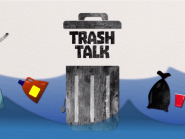Debris typically comes from both land-based and ocean-based sources.
Types and Sources
Anything man-made, including litter and fishing gear, can become marine debris once lost or thrown into the marine environment. The most common materials that make up marine debris are plastics, glass, metal, paper, cloth, rubber, and wood.
Glass, metal, and rubber are similar to plastic in that they are used for a wide range of products. While they can be worn away-broken down into smaller and smaller fragments, they generally do not biodegrade entirely. As these materials are used commonly in our society, their occurrence as marine debris is overwhelming.
Plastics are used in many aspects of daily life and are a big part of our waste stream.
Derelict fishing gear refers to nets, lines, crab/shrimp pots, and other recreational or commercial fishing equipment that has been lost, abandoned, or discarded in the marine environment.
Abandoned and Derelict Vessels
Thousands of abandoned and derelict vessels litter ports, waterways and estuaries, creating a threat to navigation, recreation, and the environment.
FAQs
“Microplastics” are pieces of plastic that are less than 5mm long. Microplastics can come from larger pieces of plastic that have broken down over and over again. Or, microplastics can be manufactured. For example, pre-production industrial plastic pellets or plastic "micro-scrubbers" in face wash are considered microplastics.
Monitoring Large Debris
Currently, no one knows exactly how much plastic marine debris enters the ocean each day, though some estimates do exist. NOAA's Marine Debris Monitoring and Assessment Project is one such effort to understand the amount of plastics on our shorelines.
Counting Microplastic Debris
What about the plastic debris pieces that are too small to count while at the beach? A laboratory method is needed to count small plastics <5mm in length, known as microplastics. Researchers at the University of Washington Tacoma, in partnership with the NOAA Marine Debris Program, have developed a reliable method to quantify microplastics (by weight) in a sand, sediment, or water sample. It has also been used to quantify plastics used in personal care products, such as facial cleansers and scrubs that use tiny plastics as abrasives. New research continues into a process to isolate microplastic particles and confirm their polymer composition (i.e., type of plastic) through infrared spectroscopy.
| Acronym | Full name | Common Example |
| PET (PETE) | Polyethylene terephthalate | soda bottles |
| PES | Polyester (yes, it’s actually a plastic!) | polyester clothing |
| PE | Polyethylene | plastic bags |
| HDPE | High-density polyethylene | detergent bottles |
| PVC | Polyvinyl chloride | plumbing pipes |
| PP | Polypropylene | drinking straws |
| PA | Polyamide (aka nylon) | toothbrushes |
| PS | Polystyrene | take-out food containers |
Plastic has the potential to harm fish and other wildlife in two main ways.
Direct Impacts - Studies have shown that fish and other marine life eat plastic. Plastics could cause irritation or damage to the digestive system. If plastics are kept in the gut instead of passing through, the animal could feel full (of plastic not food) and this could lead to malnutrition or starvation.
Indirect Impacts - Plastic debris accumulates pollutants such as PCBs (polychlorinated biphenyls) up to 100,000 to 1,000,000 times the levels found in seawater. PCBs, which were mainly used as coolant fluids, were banned in the U.S. in 1979 and internationally in 2001. It is still unclear whether these pollutants can seep from plastic debris into the organisms that happen to eat the debris and very difficult to determine the exact source of these pollutants as they can come from sources other than plastic debris. More research is needed to help better understand these areas.
Plastics will degrade into small pieces until you can’t see them anymore (so small you’d need a microscope or better!). But, do plastics fully go away? Full degradation into carbon dioxide, water, and inorganic molecules is called mineralization (Andrady 2003). Most commonly used plastics do not mineralize (or go away) in the ocean and instead break down into smaller and smaller pieces. We call these pieces “microplastics” if they are less than 5mm long. The rate of degradation depends on chemical composition, molecular weight, additives, environmental conditions, and other factors (Singh and Sharma 2008).
Bio-Based Plastics
There are some bio-based (e.g., corn, wheat, tapioca, algae) plastics on the market and in development. Bio-based plastics use a renewable carbon source instead of traditional plastics that source carbon from fossil fuels. Bio-based plastics are the same in terms of polymer behavior and do not degrade any faster in the environment.
Biodegradable Plastics
Biodegradable plastics are designed to break down in a compost pile or landfill where there are high temperatures and suitable microbes to assist degradation. However, these are generally not designed to degrade in the ocean at appreciable rates.
Plastics are used in many aspects of daily life and are a big part of our waste stream. Many plastics are colorful and will float in water, which makes plastic debris a very visible part of the marine debris problem. However, an accurate estimate does not yet exist for how much debris is composed of plastic materials.
The word “plastic” is used to describe a collection of artificial or manmade chemical compounds that come in about as many shapes, sizes, and colors as you can imagine! For example, foam carry-out containers (made of polystyrene) and bottle caps (made of polypropylene) are items that would be considered plastic marine debris if found in our oceans or waterways.



